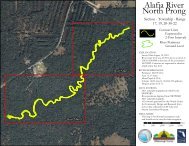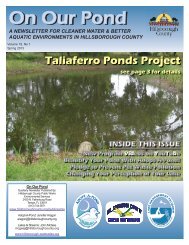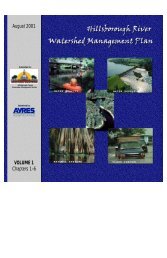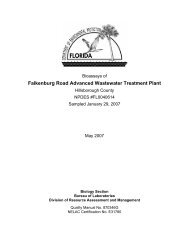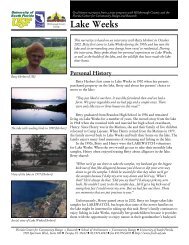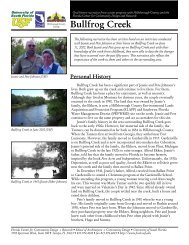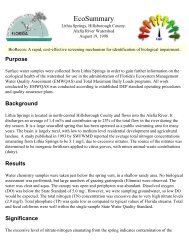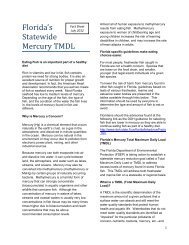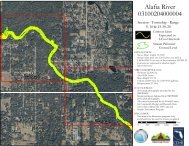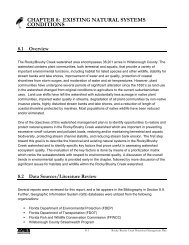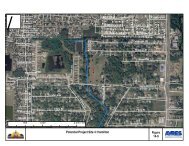Sweetwater Creek Watershed Mgmt. Plan 2007 Update--Part 2
Sweetwater Creek Watershed Mgmt. Plan 2007 Update--Part 2
Sweetwater Creek Watershed Mgmt. Plan 2007 Update--Part 2
You also want an ePaper? Increase the reach of your titles
YUMPU automatically turns print PDFs into web optimized ePapers that Google loves.
CHAPTER 11<br />
• LOS F, net load equal to or greater than 100% of untreated single family residential<br />
areas. A LOS equal to F would indicate no treatment for sub-basin discharges, or the<br />
presence of extensive areas of land uses producing larger pollution loads per unit area<br />
than typical residential land uses.<br />
11.2.1 Water Quality Level-of-Service Pollutant Load Calculations<br />
Benchmark pollutant loads were calculated for each pollutant based on the assumption that 100%<br />
of the watershed area was developed for low/medium residential land uses and no existing<br />
stormwater treatment existed in any of the subbasins. Appendix 11-1 provides a summary of the<br />
benchmark loads by subbasin for <strong>Sweetwater</strong> <strong>Creek</strong> watershed.<br />
11.2.2 Water Quality Level-of-Service Scores<br />
Based on the criteria described above, the treatment level of service designation were developed<br />
for each parameter for each subbasin, which are summarized in the Appendix 11-2. As mentioned<br />
earlier, the three most important parameters of concern in this watershed are total suspended<br />
solids, total nitrogen, and total phosphorus. The observations on these three parameters are<br />
discussed in detail in the following section.<br />
Total Suspended Solids<br />
Total suspended solids (TSS) LOS values tend to be the highest in areas dominated by existing<br />
natural systems, such as wetlands, upland forests, and rangeland (Figure 11-1). These land uses<br />
do not contribute any loads based on the model’s EMC value input dataset. However, <strong>Sweetwater</strong><br />
<strong>Creek</strong> watershed is characterized by densely developed areas. The majority of the watershed area<br />
includes such land uses as high and medium/low density residential, commercial and services,<br />
industrial, and highway/utilities. On an areal basis, a number of subbasin clusters with LOS scores<br />
of C and higher are located in the northern and central portions of the watershed. These subbasins<br />
include areas of undeveloped land, such as wetlands, small forested areas, and ponds. The area<br />
to the north of the watershed includes Avila Golf and Country Club, while the area with higher TSS<br />
LOS scores located closer to the center of the <strong>Sweetwater</strong> <strong>Creek</strong> watershed incorporates open<br />
land and small areas of wetlands located to the east of the Citrus Park Lake. Overall, the<br />
proportion of subbasins with high TSS LOS scores in the <strong>Sweetwater</strong> <strong>Creek</strong> watershed is<br />
significantly lower when compared to the proportion of similar subbasins within other watersheds in<br />
the Old Tampa Bay region (with exception of the Lower <strong>Sweetwater</strong> <strong>Creek</strong> watershed). The<br />
<strong>Sweetwater</strong> <strong>Creek</strong> watershed is much heavier polluted than most watersheds in the northwest<br />
Hillsborough County region.<br />
The remaining subbasins are dominated by the scores of F and D and are primarily characterized<br />
by high density residential, transportation and utilities, commercial and services, and industrial land<br />
uses. Developed land uses are characterized by relatively large impervious surface area (such as<br />
roads, buildings, parking lots, etc.), which have relatively high runoff coefficients and TSS loads.<br />
11-3<br />
<strong>Sweetwater</strong> <strong>Creek</strong> <strong>Watershed</strong> Management <strong>Plan</strong>



